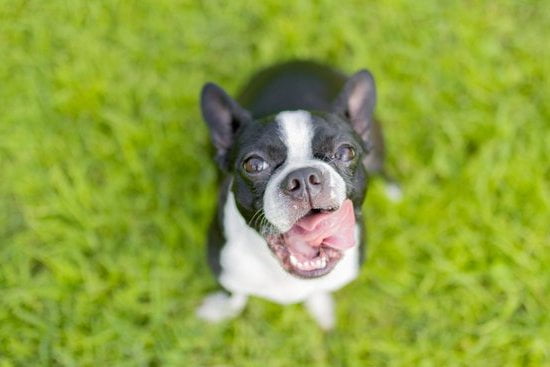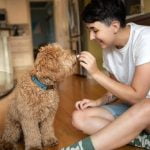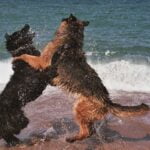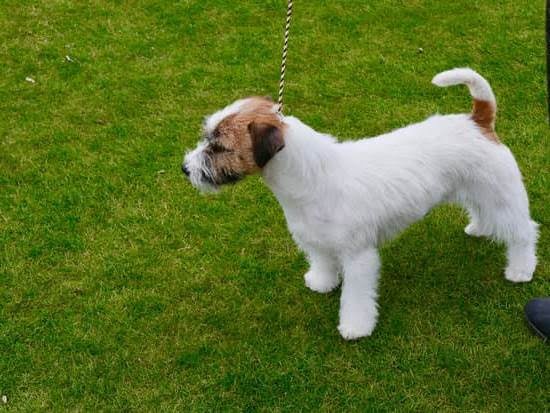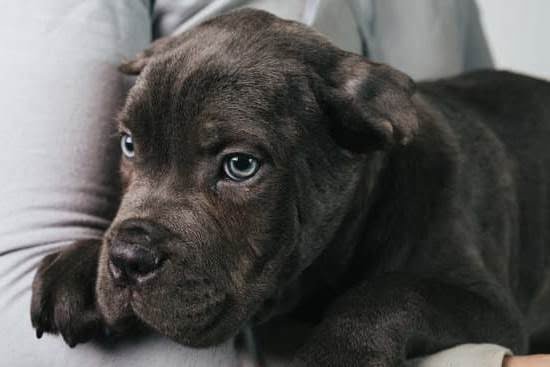Are you wondering how to train your dog not to lick your face? It can be a common behavior for dogs, but it’s important to understand why they do it and the potential dangers of allowing them to lick your face. Understanding this behavior is the first step in effectively training your dog.
Dogs licking faces is a natural behavior that stems from their instinctive desire to show affection and communicate with their owners. While it may seem harmless, there are actually some risks associated with allowing your dog to lick your face. From the spread of bacteria and parasites to potential aggression triggers, it’s important to address this behavior for the safety and well-being of both you and your furry friend.
In this article, we will explore the reasons behind why dogs lick faces, the potential dangers of allowing this behavior, and most importantly, effective training techniques for preventing face licking. By implementing positive reinforcement, distraction methods, consistency, and professional help when needed, you can enjoy a happy and healthy relationship with your dog without the unwanted face licking.
Understanding Why Dogs Lick Faces
Dogs are known for their affectionate nature, and one of the ways they express their love is by licking their owner’s face. While this behavior may seem endearing to some, it is important to understand why dogs lick faces and the potential dangers associated with allowing them to do so.
One reason why dogs lick faces is rooted in their natural instinct as puppies. When a mother dog licks her puppies’ faces, she is stimulating them and showing her affection. As a result, when dogs lick their owners’ faces, they are displaying this same affectionate behavior. Furthermore, licking also has calming effects on dogs, as it releases endorphins that help reduce stress and anxiety.
However, allowing your dog to lick your face can pose certain health risks. Dogs’ mouths contain a variety of bacteria that can be transferred to humans through licking. This can lead to infections or illnesses, especially for individuals with compromised immune systems. Additionally, continuous face licking can cause irritation to the skin and lead to unwanted behaviors such as begging for attention.
To prevent face licking behavior in dogs, it is important to implement consistent training techniques that focus on redirection and positive reinforcement. By using distraction methods such as offering a toy or treat when your dog attempts to lick your face, you can redirect their attention towards a more desirable behavior. Additionally, rewarding your dog with treats or praise when they refrain from licking your face will reinforce this positive behavior.
It’s essential to practice patience and consistency in training while setting clear boundaries for your dog regarding face licking. By employing these techniques and seeking professional training help if necessary, you can ensure a happy and healthy relationship with your canine companion without the need for face licking.
The Dangers of Allowing Your Dog to Lick Your Face
Allowing your dog to lick your face may seem like a loving and affectionate behavior, but it can actually pose some dangers to both you and your pet. While it is natural for dogs to lick as a way of showing affection, there are several reasons why allowing this behavior can be risky.
The first danger of allowing your dog to lick your face is the potential transfer of bacteria and pathogens. Dogs’ mouths are not as clean as one might think, and they can carry various bacteria and parasites that can be harmful to humans. This can lead to infections or illnesses, especially if you have any open wounds or sensitive skin on your face.
Another risk of allowing face licking is the reinforcement of dominant behavior in your dog. Allowing them to invade your personal space without boundaries may lead to behavioral issues such as aggression or possessiveness. It is important to establish yourself as the pack leader and set clear boundaries for appropriate behavior.
Lastly, allowing your dog to lick your face may send mixed signals about hierarchy within the household. By permitting this behavior, you may inadvertently confuse your dog about their role in the family dynamic, leading to potential behavioral problems in the future.
To prevent these dangers and ensure a healthy relationship with your pet, it’s crucial to train your dog not to lick your face using effective techniques and consistent training methods. The following are some helpful strategies for preventing face licking:
- Teach the “Leave It” command using positive reinforcement: Rewarding obedience.
- Distract with toys or treats when they attempt to lick.
- Consistently enforce boundaries by redirecting their attention away from trying to lick.
By implementing these techniques and staying patient and consistent in their application, you can effectively train your dog not to lick faces while maintaining a loving bond with them. Remember that professional training help is always available for more challenging cases.
Training Techniques for Preventing Face Licking
Consistency and Patience in Training
Consistency is key when it comes to training your dog not to lick your face. It’s important to establish clear boundaries and rules for your dog, and to consistently enforce them. This means not giving in to the temptation of allowing your dog to lick your face, even just once in a while. Dogs thrive on routine and structure, so being consistent in your training will help reinforce the behavior you want to see.
Patience is also essential when training your dog not to lick your face. It may take time for your dog to unlearn this behavior, especially if they have been doing it for a long time. Remember that dogs learn at their own pace, and getting frustrated or impatient with them will only hinder the training process. Stay calm, patient, and consistent with your training efforts, and you will see progress over time.
Setting Boundaries and Reinforcing Them
Setting clear boundaries with your dog is crucial in preventing face licking. Make it known that this behavior is not acceptable, and be firm in enforcing this rule. When your dog attempts to lick your face, firmly say “no” and redirect their attention elsewhere. You can also use gentle physical cues such as turning away from them or gently pushing them away to communicate that face licking is off-limits.
Reinforcing these boundaries through positive reinforcement can also be effective. When your dog refrains from licking your face or responds positively to redirection, be sure to praise and reward them. This will help them associate good behavior with rewards, making them more likely to continue following the established boundaries.
The Importance of Professional Training Help
If you’re struggling with training techniques for preventing face licking, seeking professional help from a certified dog trainer or behaviorist can be incredibly beneficial. A professional can provide personalized guidance and support based on your specific situation and your dog’s individual needs.
They can offer expert advice on effective training methods and help you develop a customized plan for addressing the issue of face licking. With their expertise and guidance, you can work towards enjoying a happy, healthy relationship with your dog without the unwanted behavior of face licking.
Positive Reinforcement and Reward-Based Training Methods
When it comes to training a dog not to lick your face, positive reinforcement and reward-based training methods can be highly effective. These methods focus on rewarding your dog for desired behaviors, rather than punishing them for unwanted behaviors. Here are some techniques that you can use to train your dog not to lick your face:
1. Use treats: When your dog refrains from licking your face, immediately reward them with a treat. This positive reinforcement will help them understand that not licking your face results in a tasty reward.
2. Verbal praise: Along with treats, verbal praise can also be a powerful tool for reinforcing good behavior. Whenever your dog shows restraint from licking your face, shower them with verbal praise and affection to reinforce the behavior.
3. Clicker training: Clicker training is another effective method for enforcing positive behaviors. Use a clicker to mark the moment when your dog refrains from licking and follow it up with a treat or praise.
Remember, consistency is key when using positive reinforcement and reward-based training methods. Be sure to always have treats or rewards on hand whenever you are interacting with your dog, so you can immediately reinforce their good behavior.
By using these reward-based techniques, you can effectively train your dog not to lick your face while strengthening the bond between you and your furry friend. With patience and consistent effort, you can enjoy a happy, healthy relationship with your dog without having to worry about them licking your face constantly.
Using Distraction and Redirecting Techniques
Dogs lick faces as a way of showing affection and seeking attention, but it can be an undesirable behavior for many pet owners. Utilizing distraction and redirecting techniques can be effective in training your dog not to lick your face. These techniques focus on redirecting your dog’s attention away from licking and onto a different, more suitable behavior.
One effective distraction technique is to provide your dog with an alternative behavior to engage in when they start to lick your face. This could include asking them to sit, shake paws, or lie down. By redirecting their focus onto a different action, you are effectively preventing them from licking your face and reinforcing positive behaviors.
Another useful method is to use toys or treats as a form of distraction. When you notice your dog starting to lick your face, offer them a toy or treat to shift their attention away from the behavior. This not only redirects their focus but also reinforces the idea that there are more appropriate ways for them to seek attention and affection.
Consistency is key when using distraction and redirecting techniques to train your dog not to lick your face. It may take time for your dog to fully understand and comply with the new expectations, so patience and persistence are essential in this training process. It is important for all members of the household to be consistent in applying these techniques, as mixed messages can confuse the dog and hinder progress.
By implementing distraction and redirecting techniques, along with positive reinforcement methods, you can effectively train your dog not to lick your face while still maintaining a loving and healthy relationship with them. Remember that every dog is unique, so finding the best approach that works for both you and your pet may require some trial and error.
If you find it challenging to train your dog using these techniques on your own, seeking professional training help can provide valuable guidance and support in addressing this behavior.
Consistency and Patience in Training
Consistency and patience are key elements when it comes to training your dog not to lick your face. It’s important to remember that dogs thrive on routine and repetition, so being consistent with your training methods is crucial for success. This means practicing the same techniques every day and not wavering in your approach.
When working to train your dog not to lick your face, it’s essential to be patient as well. Changing a behavior takes time, and some dogs may require more time than others to understand and obey the command. Losing patience can negatively impact the training process, so it’s important to remain calm and understanding throughout.
One effective way to maintain consistency and patience in training is by using positive reinforcement methods. This involves rewarding your dog for good behavior rather than punishing them for unwanted behaviors. By consistently rewarding your dog when they refrain from licking your face, they will begin to associate not licking with positive outcomes.
Implementing distraction and redirecting techniques can also help reinforce consistency in training. If you notice your dog starting to move towards licking your face, quickly redirect their attention by giving them a toy or asking them to perform a known command. Consistently utilizing these redirection methods will reinforce the message that face licking is an undesired behavior.
| Training Techniques | Description |
|---|---|
| Positive Reinforcement | Rewarding good behavior rather than punishing unwanted behaviors. |
| Distraction and Redirecting | Quickly redirecting their attention when they start towards face licking. |
| Consistency | Practicing the same techniques every day without wavering. |
Setting Boundaries and Reinforcing Them
When it comes to training your dog not to lick your face, setting clear boundaries and consistently reinforcing them is crucial. This section will explore the importance of establishing boundaries for your dog and the techniques for reinforcing them effectively.
Establishing Clear Boundaries
The first step in preventing your dog from licking your face is to establish clear boundaries. Decide on a specific command or cue that indicates to your dog that face licking is not allowed. This could be a verbal command such as “No licking” or a physical cue such as turning away from your dog when they attempt to lick your face.
Consistent Reinforcement
Once you have set the boundaries, it is essential to consistently reinforce them. Every time your dog attempts to lick your face, respond immediately with the chosen command or cue. Be firm and consistent in your response, so that your dog understands that face licking is not acceptable behavior.
Positive Reinforcement
In addition to setting boundaries and consistently enforcing them, it is important to use positive reinforcement to encourage desirable behavior. Whenever your dog refrains from licking your face, provide praise, treats, or affection as a reward. This will help reinforce the idea that not licking faces leads to positive outcomes.
By setting clear boundaries, consistently reinforcing them, and using positive reinforcement, you can effectively train your dog not to lick your face. Remember that training takes time and patience, so be persistent in implementing these techniques and enjoy a healthy relationship with your dog free of face licking.
The Importance of Professional Training Help
When it comes to training your dog not to lick your face, seeking the help of a professional trainer can be incredibly beneficial. Professional trainers have the knowledge and expertise to understand the underlying reasons for your dog’s behavior and can provide personalized guidance to address the issue effectively.
One of the key benefits of enlisting the help of a professional trainer is their ability to assess your dog’s behavior and create a customized training plan. They can identify any underlying causes or triggers for the face licking behavior and develop a comprehensive approach to address it.
Professional trainers also have access to a variety of training tools and techniques that may not be readily available to pet owners. They can implement specialized methods that are tailored to your dog’s individual needs, making the training process more effective and efficient.
Furthermore, working with a professional trainer can provide you with ongoing support and guidance as you navigate the training process. They can offer valuable advice on how to reinforce positive behaviors, troubleshoot any challenges you may encounter, and ensure that you remain consistent in your approach.
| Benefits | Professional Training Help |
|---|---|
| Personalized Guidance | Trainers understand underlying reasons for behavior |
| Access to Specialized Techniques | Implementing tailored methods for individual dogs |
| Ongoing Support | Providing guidance and troubleshooting during training process |
Conclusion
In conclusion, while it is natural for dogs to want to show affection by licking their owners’ faces, there are important reasons why this behavior may need to be addressed and trained. By understanding the motivations behind face licking and the potential risks involved, dog owners can take proactive steps to prevent this behavior in a positive and effective way.
Utilizing training techniques such as positive reinforcement, distraction, consistency, and setting boundaries can help teach dogs not to lick faces. It is essential for dog owners to be patient and dedicated in implementing these methods, as changing ingrained behaviors takes time and effort. By doing so, they can enjoy a happy, healthy relationship with their furry companions without facing the discomfort or risks associated with face licking.
For those who may struggle with training their dog not to lick faces on their own, seeking professional help from a certified dog trainer or behaviorist can provide valuable guidance and support. With the right approach and dedication, both dogs and their owners can communicate love and affection in ways that are mutually enjoyable and safe. By understanding how to train a dog not to lick one’s face effectively, a harmonious bond between pet and owner can be cultivated.
Frequently Asked Questions
How Do I Get My Dog to Stop Licking My Face?
Getting your dog to stop licking your face requires consistent training and positive reinforcement. You can use commands like “no lick” and redirect your dog’s attention to a toy or activity to discourage the behavior.
What Does It Mean When a Dog Obsessively Licks Your Face?
When a dog obsessively licks your face, it could be a sign of submission, affection, or even anxiety. It’s their way of showing affection and seeking attention from their owner. However, excessive licking can also be a compulsive behavior that may need professional intervention.
Do Dogs Get Sad When You Don’t Let Them Lick Your Face?
Dogs may feel disappointed if they’re not allowed to lick your face, especially if it’s a behavior they’ve been accustomed to. However, dogs are adaptable and will eventually learn to find other ways to show affection towards their owners.
As long as they receive love and attention in other ways, they won’t be permanently sad about not licking your face.

Welcome to the blog! I am a professional dog trainer and have been working with dogs for many years. In this blog, I will be discussing various topics related to dog training, including tips, tricks, and advice. I hope you find this information helpful and informative. Thanks for reading!

